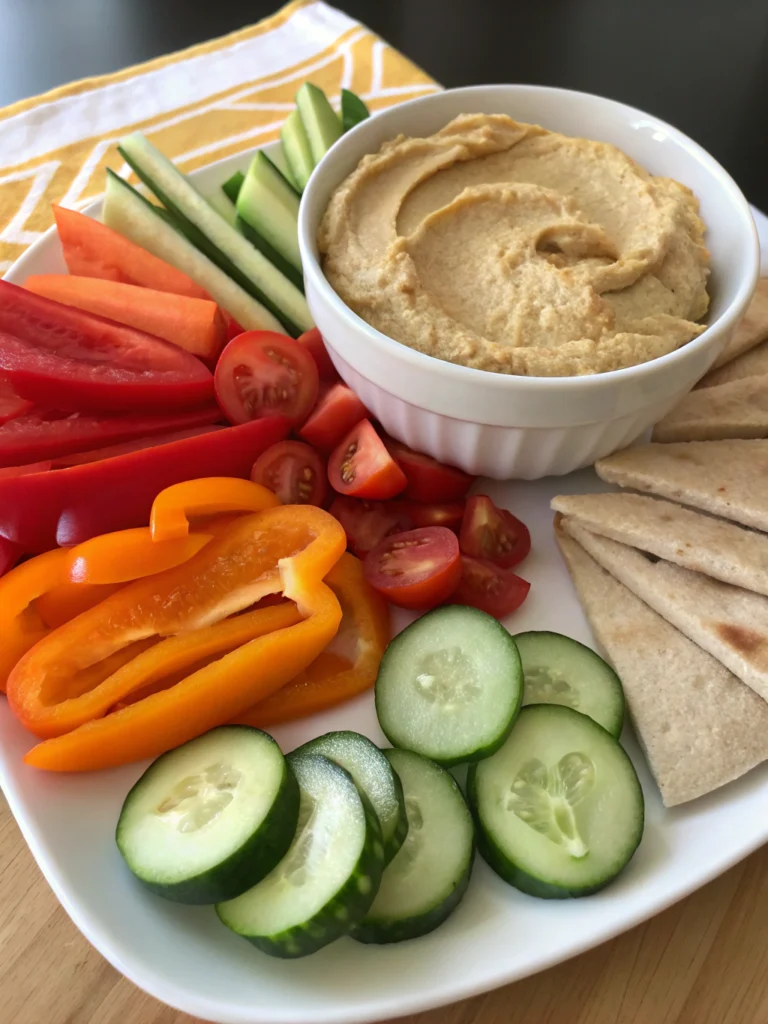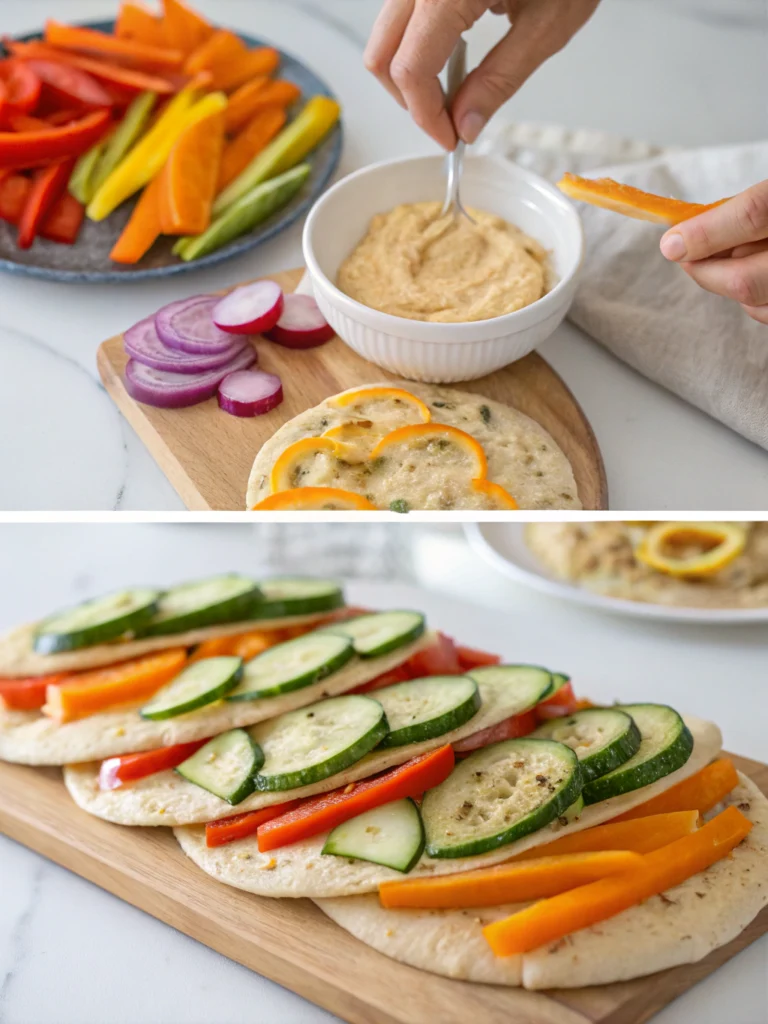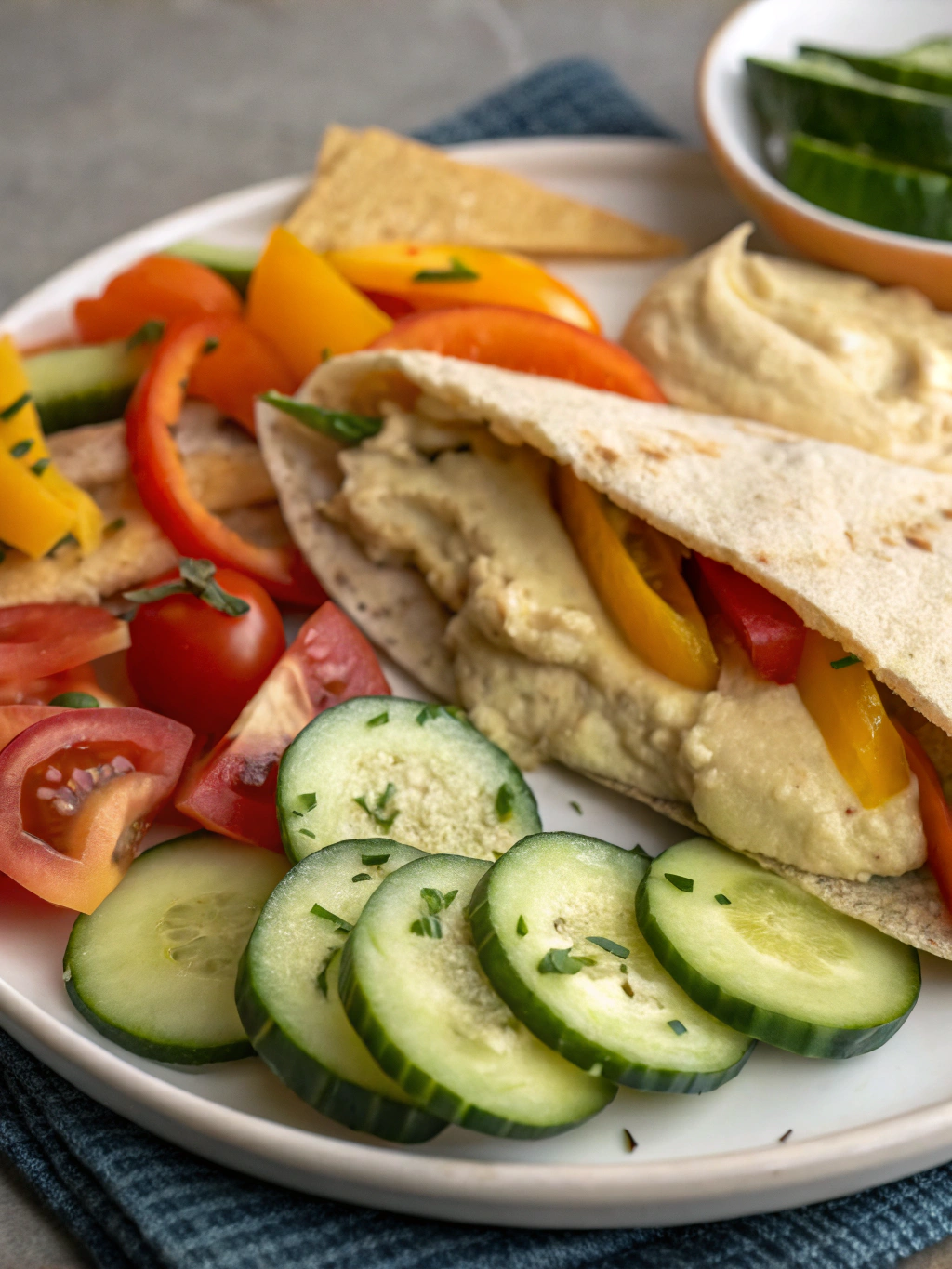Ever wondered how to create a meal that’s bursting with color, nutrition, and flavor without spending hours in the kitchen?
This veggie hummus pita recipe makes it easier than ever to eat healthy without cooking..
These veggie hummus pita pockets are a game-changer for busy weeknights, lunch boxes, or even casual entertaining. Packed with rainbow vegetables and creamy hummus, all tucked into warm, fluffy pita bread, this no cook pita recipe delivers maximum satisfaction with minimal effort.
Packed with rainbow vegetables and creamy hummus, all tucked into warm, fluffy pita bread, this no cook pita recipe delivers maximum satisfaction with minimal effort.
- These veggie hummus pita pockets are the perfect grab-and-go solution when time is tight but nutrition matters.
Whether you’re a seasoned cook looking for a quick meal solution or a beginner in the kitchen seeking foolproof recipes, these colorful pockets will quickly become your go-to option for nutritious eating on the go.
Ingredients List
Here’s everything you’ll need to make the perfect veggie hummus pita pockets at home — fresh, flavorful, and easy to prepare!

- 4 whole wheat pita pockets – Choose ones with a good pocket that opens easily; substitute with gluten-free pita if needed
- 1 cup hummus – Store-bought or homemade; classic, roasted red pepper, or garlic flavors work wonderfully
- 1 medium cucumber – Sliced into thin half-moons; English cucumbers have fewer seeds and more crunch
- 1 medium carrot – Grated or cut into matchsticks for the perfect texture
- 1 red bell pepper – Thinly sliced; yellow or orange peppers make excellent substitutes
- 1 cup baby spinach leaves – Can swap with arugula for a peppery kick or mixed greens
- ½ cup red cabbage – Thinly shredded for color and crunch; green cabbage works too
- ¼ cup red onion – Thinly sliced; soak in ice water for 10 minutes to reduce sharpness if desired
- ¼ cup kalamata olives – Pitted and sliced; optional but adds wonderful tanginess
- 2 tablespoons fresh lemon juice – For drizzling; lime juice works as an alternative
- 2 tablespoons extra virgin olive oil – For drizzling; avocado oil is a good substitute
- Salt and freshly ground black pepper – To taste
- ¼ cup fresh herbs – Chopped parsley, mint, cilantro, or a combination
Timing
Preparation Time: 15 minutes
Cooking Time: 0 minutes (truly no-cook!)
Total Time: 15 minutes
This veggie hummus pita recipe takes 75% less time than the average weeknight dinner, which typically requires 40-60 minutes. The quick prep makes it perfect for those evenings when cooking feels impossible but you still want something nutritious and satisfying.
Step-by-Step Instructions

Step 1: Prepare Your Vegetables
Wash all vegetables thoroughly under cold running water. Pat dry with clean kitchen towels or paper towels. Slice the cucumber into thin half-moons, grate or julienne the carrot, thinly slice the bell pepper and red onion, and shred the red cabbage. Having all vegetables prepped before assembly creates a smooth workflow.
Step 2: Warm the Pita Bread
Though this is a veggie hummus pita recipe with no cooking required, slightly warming your pita bread makes it more pliable and enhances flavor. Wrap pitas in a slightly damp paper towel and microwave for 15-20 seconds, or toast them lightly in a dry skillet for 30 seconds per side until soft but not crispy.
Step 3: Create the Base Layer
Carefully open each pita pocket along its seam, creating a pocket while keeping the bread intact. Spread about 2 tablespoons of hummus inside each pita, coating both the front and back inner walls. This creates a flavorful base and helps the vegetables adhere to prevent them from falling out while eating.
Step 4: Layer the Vegetables
- Start with a layer of spinach leaves to create a moisture barrier between the hummus and juicier vegetables
- Add cucumber slices and grated carrots
- Layer in bell pepper strips and red cabbage for color contrast
- Sprinkle with red onion slices and olives (if using)
Arrange vegetables in rainbow order for visual appeal, and avoid overstuffing which can cause the pita to tear.
Step 5: Add Final Touches
Drizzle the inside of each pocket with a little olive oil and fresh lemon juice. Season with a pinch of salt and freshly ground black pepper. Sprinkle with chopped fresh herbs. These finishing elements bring brightness and tie all the flavors together into a cohesive, delicious whole.
Nutritional Information
Each veggie hummus pita pocket contains approximately:
Calories: 320
Protein: 10g
Carbohydrates: 42g
Dietary Fiber: 8g
Sugars: 5g
Fat: 14g (mostly heart-healthy unsaturated fats)
Sodium: 480mg
Vitamin A: 80% of daily value
Vitamin C: 75% of daily value
Calcium: 10% of daily value
Iron: 15% of daily value
This nutrient-dense meal provides 30% more fiber than the average lunch option, supporting digestive health and sustained energy. The combination of whole grains, plant proteins, and fresh vegetables creates a balanced meal that helps maintain steady blood sugar levels throughout the afternoon.
Healthier Alternatives for the Recipe
While this recipe is already quite nutritious, here are some ways to adapt it for specific dietary needs:
Lower Carb Option: Replace traditional pita with lettuce wraps or low-carb tortillas. You’ll maintain the satisfying handheld experience while reducing the carbohydrate content by approximately 60%.
Higher Protein Version: Add 2-3 ounces of grilled chicken, falafel, or tempeh to each pocket. This modification increases protein content by 15-20 grams per serving, making it more satiating for active individuals.
Reduced Sodium Choice: Make your own hummus without added salt and use fresh vegetables rather than pickled or preserved ones. This simple change can reduce sodium content by up to 40%.
Anti-Inflammatory Focus: Add turmeric to your hummus and include extra virgin olive oil with a sprinkle of black pepper to enhance absorption of curcumin, the active anti-inflammatory compound in turmeric.
Serving Suggestions
Transform these vibrant pita pockets from a simple meal to a memorable dining experience with these serving ideas:
Mezze Platter: Serve halved pita pockets alongside small bowls of extra hummus, tzatziki, marinated feta, and olives for a Mediterranean-inspired feast that encourages customization and conversation.
Lunchbox Solution: Pack components separately and assemble just before eating to maintain optimal texture. Include a small container of lemon-tahini dressing on the side for an extra flavor boost.
Family-Style Assembly: Create a colorful DIY pita pocket bar with all ingredients arranged in separate bowls. This interactive approach is perfect for family dinners or casual gatherings, allowing everyone to customize their pocket.
Seasonal Adaptations: In summer, add fresh peach or watermelon chunks for a sweet contrast; in fall, incorporate roasted sweet potato cubes; in winter, add roasted red peppers for warmth and depth.
Common Mistakes to Avoid
- Overstuffing the pita: This leads to tearing and difficult eating. Instead, distribute ingredients evenly and compress slightly before the final fold.
- Skipping the moisture barrier: Without spreading hummus on both inner sides of the pita, juicy vegetables can make the bread soggy. The hummus creates a protective, flavorful seal.
- Using cold pita bread: Room temperature or slightly warmed pita is more pliable and less likely to crack. Cold pita from the refrigerator often breaks when folded.
- Cutting vegetables too large: Chunky vegetables can tear the pita and make eating awkward. Aim for thin, uniform slices that distribute flavor evenly in each bite.
- Assembling too far in advance: Ideally, assemble within 2-3 hours of eating. For meal prep, store components separately and assemble just before consumption.
Storing Tips for the Recipe
For the freshest experience, these pita pockets are best enjoyed immediately after assembly. However, modern life often requires advance preparation, so here’s how to maintain quality:
Make-Ahead Components: Prep all vegetables up to 3 days in advance and store them in separate airtight containers lined with paper towels to absorb excess moisture. This simple technique extends freshness by absorbing condensation that would otherwise cause wilting.
Storing Assembled Pockets: If you must store assembled pockets, wrap each one tightly in parchment paper, then aluminum foil. Consume within 4-6 hours for optimal texture and flavor. The parchment prevents the aluminum from reacting with the acidic ingredients.
Freezing Option: While the assembled pockets don’t freeze well, you can freeze pita bread for up to 3 months. Thaw at room temperature for 30 minutes or microwave for 10-15 seconds before using.
Reviving Technique: If your assembled pocket becomes slightly soggy, a 2-minute toast in a dry skillet can restore some crispness to the exterior while keeping the filling fresh and vibrant.
Conclusion
These rainbow veggie hummus pita pockets represent the perfect intersection of nutrition, convenience, and flavor. With zero cooking time and endless customization possibilities, they’re an ideal solution for busy weeknights, packed lunches, or casual entertaining.
The combination of protein-rich hummus, fiber-packed vegetables, and satisfying whole grain pita creates a balanced meal that will keep you energized throughout your day without weighing you down.
Have you tried making these colorful pita pockets? Share your favorite vegetable combinations or additional tips in the comments below! And if you enjoyed this recipe, be sure to check out our other quick plant-based meals that prove healthy eating doesn’t have to be complicated or time-consuming.

